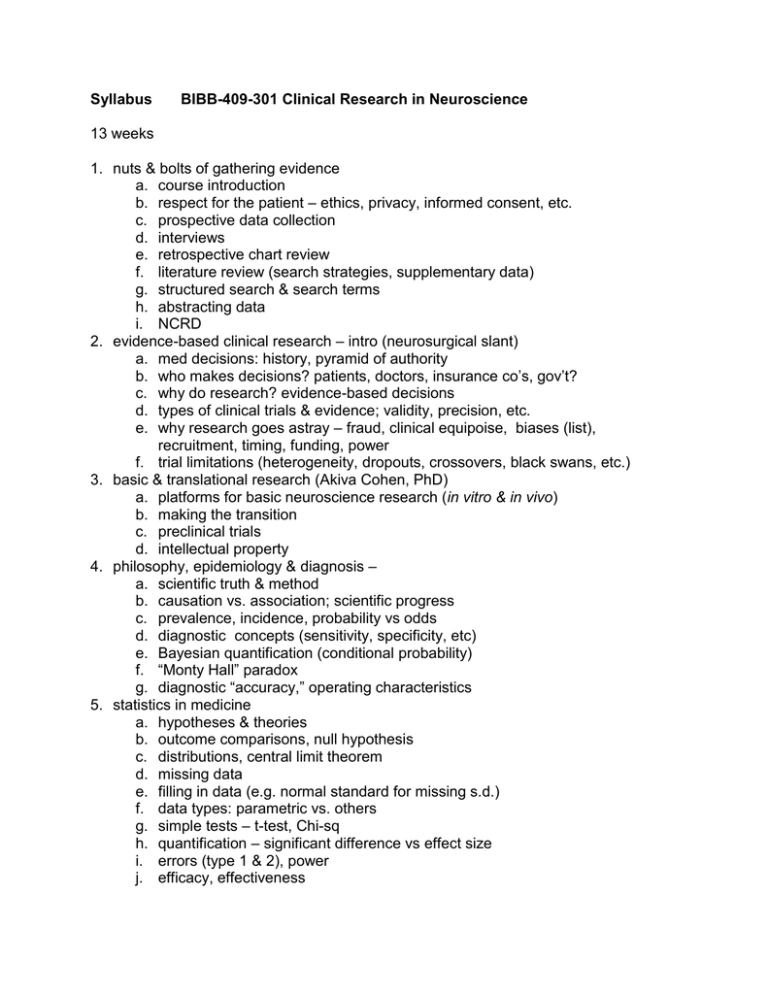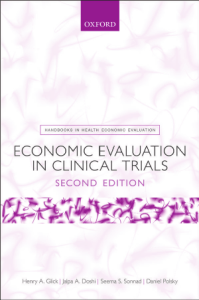BIBB 409.docx
advertisement

Syllabus BIBB-409-301 Clinical Research in Neuroscience 13 weeks 1. nuts & bolts of gathering evidence a. course introduction b. respect for the patient – ethics, privacy, informed consent, etc. c. prospective data collection d. interviews e. retrospective chart review f. literature review (search strategies, supplementary data) g. structured search & search terms h. abstracting data i. NCRD 2. evidence-based clinical research – intro (neurosurgical slant) a. med decisions: history, pyramid of authority b. who makes decisions? patients, doctors, insurance co’s, gov’t? c. why do research? evidence-based decisions d. types of clinical trials & evidence; validity, precision, etc. e. why research goes astray – fraud, clinical equipoise, biases (list), recruitment, timing, funding, power f. trial limitations (heterogeneity, dropouts, crossovers, black swans, etc.) 3. basic & translational research (Akiva Cohen, PhD) a. platforms for basic neuroscience research (in vitro & in vivo) b. making the transition c. preclinical trials d. intellectual property 4. philosophy, epidemiology & diagnosis – a. scientific truth & method b. causation vs. association; scientific progress c. prevalence, incidence, probability vs odds d. diagnostic concepts (sensitivity, specificity, etc) e. Bayesian quantification (conditional probability) f. “Monty Hall” paradox g. diagnostic “accuracy,” operating characteristics 5. statistics in medicine a. hypotheses & theories b. outcome comparisons, null hypothesis c. distributions, central limit theorem d. missing data e. filling in data (e.g. normal standard for missing s.d.) f. data types: parametric vs. others g. simple tests – t-test, Chi-sq h. quantification – significant difference vs effect size i. errors (type 1 & 2), power j. efficacy, effectiveness k. regression, survival studies 6. Neurocritical care research; bioinformatics – storing, manipulating and mining data (Joshua Levine, MD; Soojin Park, MD) a. opportunities for research in NeuroICU b. challenges of the ICU setting (care vs. research, consent, privacy, etc.) c. architecture & examples of use in an ICU d. creating a research database e. searching and utilizing databases for research f. challenges and obstacles g. examples 7. planning clinical trials a. important questions – framing your hypothesis b. literature review hypotheses c. choosing what data you need (intent to treat) d. outcome parameter(s) e. power – sample size f. industrial research – different motivations, financial incentives, regulation (details), ethics g. Phases for drug clinical trials (I-IV) 8. meta-analysis – pooling data from multiple trials a. why done – conflicting & underpowered trials b. random vs. fixed-effects models c. Forest diagrams d. weighting pooled data i. unweighted ii. n-weighted iii. variance-weighted e. pooling observational data (Einarsson) f. meta-regression g. decision analysis h. introduction – why, comparative effectiveness i. decision tree (exhaustive & mutually exclusive categories) j. transition probabilities k. utility & QOL l. data sources: educated guess, single study, meta-analytic pooling m. roll-back analysis 9. Advanced D/A topics a. temporal effect – LYs & QALYs b. Markov processes c. variance and uncertainty d. sensitivity analysis e. Monte Carlo simulation 10. Economics, Cost-Effectiveness a. societal background b. perspective c. components d. determining costs e. incremental cost-effectiveness ratio (ICER) f. discounting g. willingness-to-pay h. handling uncertainty i. examples 11. medical writing a. manuscript structure b. economy c. style 12. review & present projects 13. review & present projects



